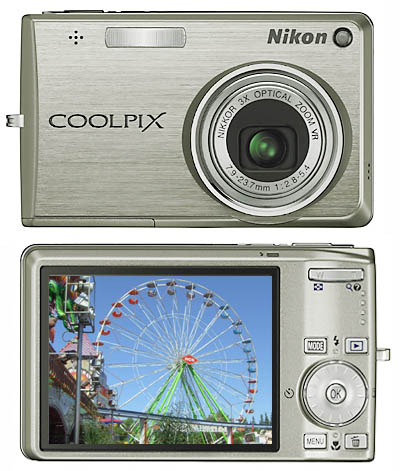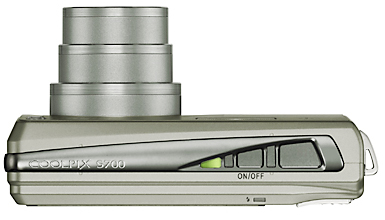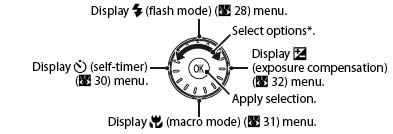|
Nikon Coolpix S700
12.1 megapixel in a stylish, high-tech ultra-compact
(by Conrad H. Blickenstorfer)
Almost everyone now offers lots of megapixel and a slew of advanced features at very low cost, so manufacturers have been forced to differentiate low and high end cameras in different ways. The current approach is to have different "families" of cameras, with each appealing to a different group of customers. The new Coolpix S700, for example, is part of Nikon's "Style" series, a line that combines sophisticated elegance with advanced technology and speed.
One of two S-Series cameras introduced by Nikon in the Fall of 2007, the 12.1 megapixel Coolpix S700 has the highest resolution currently available in consumer cameras, offers sophisticated vibration reduction technologies for still and moving pictures, and comes in an elegant brushed aluminum body. The camera also has very high ISO 3200 sensitivity for shooting in low light, is compatible with the new high capacity SDHC storage cards, and it is equipped with all of Nikon's latest "In-Camera innovations" that make for optimal pictures.

Elegance and performance
The Apple iPod has shown that when it comes to certain consumer electronics, style and design are everything. The iPod prevailed over worthy competitors because it looked better and was simpler to use than anything else. No camera has yet achieved the iconic status of the iPod or has grabbed an iPod-like market share for itself. However, there are styles that consumers simply like, and Nikon knows that. One such style is the small, boxy, metallic look originally pioneered by Canon with its digital ELPH several years ago. That sculpted-from-a-block-of-metal look has never gone out of style, and the chunky little blocks remain as popular as ever, even in this era of ultra-slims that have become the ultimate instant attention grabbers.
The S700 is certain to grab a good deal of attention itself. It's a very handsome camera with an elegant brushed aluminum finish. And with a footprint of 3.5 x 2.1 inches the S700 is very small. That's almost exactly the profile of a credit card. However, it is almost an inch thick and that gives it a chunky feel very much unlike that of the ultra-thins. Most of the backside is taken up by a superb high resolution LCD with anti-reflection coating. It measures 2.7 inches diagonally (versus 2.5 inches of the also-new S510), its 230,000 pixels offer a very sharp and pleasant image, and the anti-reflective coating makes for very good outdoor viewability. To the right of the big display are the few hardware controls, all nicely and logically arranged.

The front of the S700 is flat and very clean. Five little dots mark the microphone, the tiny flash and the AF-illuminator light sit along the top of the camera. The barrel itself is large, and the actual lens sits off-center. Nikon masked that with a black insert. The lens barrel itself is big and motors out a very significant distance when you turn the camera on (see above). There are lots of arguments pro and con internal folding zoom mechanisms. Personally, in a stylish camera like the S700, I'd have preferred a fully internal zoom.
Advanced technology
While 8 megapixel is good, 12 is certainly better, and that alone will put the S700 high on the list of potential buyers. It means 4,000 x 3,000 pixels, enough for huge prints and whatever cropping and editing you need done on a picture. No such excess on the zoom department, however. Despite that massive lens barrel, 3X optical is all you get in the S700's 35-105mm equivalent 3X Zoom-Nikkor glass. An available 4X digital zoom multiplies that to a maximum 12X magnification.
2007 was the year where the digital camera industry tackled the issue of blurred pictures due to zooming, movement or not enough light. Virtually every new digital compact has some sort of anti-shake or anti-blur or anti-vibration mechanism. At the low end is digital anti-blur, which essentially just increase sensitivity and then snaps the picture at a higher shutter speed. That can add graininess. "Active" methods measure camera movement and then either shift the lens or the imager itself to counteract the movement. We've done a good number of tests, and the systems work.
So what has Nikon done for anti-blur in its flagship "Style" camera? Quite a bit. For example, it equipped the S700 with separate anti-blur mechanisms, which Nikon usually calls "vibration reduction" or "VR." Still pictures use an optical vibration reduction which Nikon calls image-sensor shift. This is an active optical shift anti-shape technology that senses movement perpendicular to the panning. So if you pan horizontally, the VR mechanism will reduce vertical shake; if the camera pans vertically, horizontal shake is smoothed out. This can be enabled or disabled in settings.
For movies, there is a different type, "electronic VR." This is designed to reduce the impact of camera shake in all movie modes except for the camera's time lapse mode where you can shot one shot every 30 seconds up to every hour.
Nikon is proud of speeding up the S700 and claims the camera has a start-up time of only about 0.7 seconds, and a shutter lag of just five milliseconds. In addition, Nikon's new EXPEED processing engine gives the S700 enhanced image processing and brilliant color reproduction.
Like its other cameras new for the Fall of 2007, the S700 incorporates a series of "Nikon In-Camera Innovations." They include In-Camera Red-Eye Fix, D-Lighting, and Face Priority AF. In-Camera Red-Eye Fix automatically detects and corrects red eye, a common condition that happens when you use the flash. In playback mode, D-Lighting compensates for excessive back-light or insufficient flash in images. What happens with D-Lighting is that the camera software creates a copy of a picture with enhanced brightness and contrast where it tries to boost dark and underexposed areas.
Face recognition, or "face priority," seems to be a must-have feature of virtually every consumer camera introduced in 2007 and the Coolpix S700 is no exception. The camera offers a "Face Priority" mode that makes sure the camera exposes faces properly. What that means is that the camera has the ability too find a face in a picture and then make sure that it is in focus and properly exposed. With the S510, you know face priority works when a double border around the face glows green. In fact, the face recognition function in the S510 can recognize up to a dozen separate faces quickly and efficiently.
The S700 also has Nikon's exclusive Best Shot Selector (BSS) that snaps up to ten frames and automatically selects the sharpest one. This feature is meant to be used with the flash off or fully zoomed in, or in other situations where unwanted blurring may happen. Other modes include "Continuous" that shoots five shots in one-second interval; Multi-Shot 16, where 16 pics are shot at one-second intervals and then arranged in a 4 x 4 grid on one image; and Interval Shooting where you can direct the camera to do up to 1,800 frames with 30 seconds to an hour between each shot. This is in addition to the time-lapse movie feature.
The rotary multi selector
Like the Coolpix S510, Nikon's other new "Style" model, the S700 has a "rotary multi selector" that seeks to combine the mode dial and the navigation disc into an unmarked multi-function selector disc/ring. This requires a bit of getting used to.
You can use the multi selector ring like a standard navigation disc. You can also use it to toggle through flash, self timer, exposure compensation and macro mode settings by pressing down on its four sides. And to select various options you can rotate it like a mode dial to select various options both in record and playback mode. Sometimes an onscreen representation of the multi selector appears on the LCD, providing labels so you can rotate until you get to the selection you want. The multi selector works well, it's just that it is a bit different from what most digital photographers are used do. The illustration below is from the S700's manual and shows how the selector works when the camera is in recording mode.

In terms of shooting modes, those are selected via an onscreen dial.
There is a high-sensitivity mode that increases sensitivity up to ISO 1600 and increase shutter speed.
There are there are 15 "scene modes," those being portrait, landscape, sports, night portrait, party/indoor, beach/snow, sunset, dusk/dawn, night landscape, close-up, museum, fireworks, copy (to take clear pictures of text and print), backlight and panorama assist.
Voice recording is available both as a freestanding feature (record til full) or as voice annotations to pictures (up to 20 seconds).
In movie mode you can record at full 640 x 480 resolution and at a lifelike 30 frames per second, with sound. Recording time is only limited by storage capacity. Unfortunately, like all other new Coolpix models, the S700 won't let you operate the optical zoom while shooting movies; digital zoom is available but only up to 2X. That was an unwelcome surprise. On the plus side, you can do those time-lapse movies with intervals between shots from 30 seconds to 60 minutes.
There are no manual modes; the S700 is strictly a point & shooter.
What does the S700 have over the also-new S510?
If you like the stylish S700, but find the US$379 list price a bit beyond your allocated budget, you might consider the Coolpix S510 that lists for US$80 less. You definitely get less: 81. instead of 12.1 megapixel; a 2.5 instead of a 2.7-inch LCD; a max ISO sensitivity of 2000 instead of 3200; no distortion control; no dual vibration control; a bit less shutter speed; and you can't get as close in macro mode (6 vs 2.4 inches). Though it's not cheap, we'd consider the S700 a better deal.
Overall
The Coolpix S700 is a elegant, small and handy camera that emphasizes style and plenty of technology. It has spectacular 12.1 megapixel resolution and comes in a very elegant brushed aluminum housing. It's small enough to fit anywhere, yet has a very large and razor-sharp 2.7-inch LCD that remains quite readable outdoors thanks to an anti-reflection coating. The design is clean and uncluttered, though the somewhat unusual multi selector ring requires a bit of getting used to.
The S700 is a speedy point & shooter without manual control. It offers full voice recording, VGA movies with sound and even time-lapse movies. Active image sensor vibration reduction eliminates most blur when you zoom. Movies use a separate electronic blur reduction mode. It also includes a slew of Nikon's in-camera goodies and technologies, including distortion control. The S700 is not inexpensive, but it definitely offers enough to warrant its premium price.
We like:
- 12.1 megapixel resolution
- Terrific hi-res 2.7 inch screen
- Elegant brushed aluminum design
- Very small and handy
- Optical sensor-shift image stabilization AND electronic VR
- Face recognition mode, distortion control and more
- Voice recording
- Full speed VGA movies with sound
Not so much:
- No optical zoom during movies
- Multi selector a bit cumbersome
- Costly
|